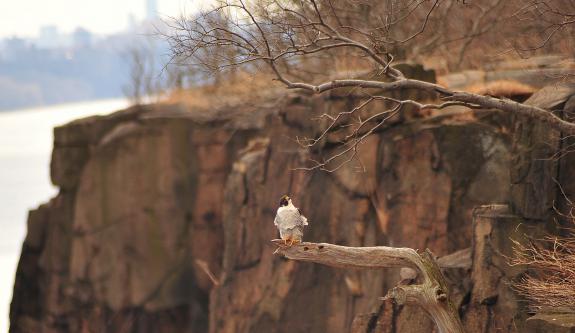Peregrine Falcon
The fastest animal on the planet, peregrine falcons, can reach speeds of over 200 miles per hour. They became endangered in New Jersey, and across the world, due to the use of harmful pesticides such as DDT.

Peregrine Falcons, Falco peregrinus, dive faster than any other bird of prey in the world, reaching speeds of over 200 miles per hour. Though they are the world’s most widespread raptor and one of the most widely found bird species, Peregrine Falcons became endangered in many locations due to the use of harmful pesticides, especially DDT.
When DDT use became widespread in the 1950’s, it slowly entered the food chain and affected the raptors when they ate other animals that had consumed the toxin. DDT caused the adult falcons to lay thin eggs that cracked underneath them during incubation, or caused the young chicks to die early. By 1964, these birds of prey were essentially gone east of the Mississippi River. The Peregrine Falcon was federally listed as endangered under the Endangered Species Conservation Act of 1969.
The New Jersey Division of Fish and Wildlife began a restoration program in 1975 to bring back the Peregrine Falcon population. Hacking, or placing captive bred birds in boxes meant to mimic a natural nest site, began statewide. Young chicks were bred and raised in captivity, then gradually released along the coast from hacking towers built across the state. This process continued until 1980, with a total of 55 young birds released.
 Zoom+ The male peregrine falcon that nests atop 101 Hudson St. in Jersey City. © Kathy Clark, ENSP
Zoom+ The male peregrine falcon that nests atop 101 Hudson St. in Jersey City. © Kathy Clark, ENSP
In 1980, the first wild nesting occurred at Forsythe National Wildlife Refuge in Brigantine, Atlantic County. In New Jersey, the Peregrine’s recovery continues to grow at a slow but steady pace. Today, there are 26 known nesting pairs in habitats throughout the state. Though their reproduction remains strong, biologists are concerned for the Peregrine’s long-term recovery. Pesticides, PCBs, and heavy metals continue to threaten their population.
Peregrine Falcons usually nest in mountain ranges, river valleys, or along coastlines, but they now nest increasingly in cities and urban areas. Though New Jersey is one of the most densely populated states, the falcons have found suitable habitat with plenty of ledges to nest on and abundant prey close by.
Peregrines are primarily bird-eating raptors, but will occasionally hunt small mammals, reptiles, and even insects. The falcons can grow to a body length of 13 to 23 inches with a wingspan reaching lengths ranging from 29 to 47 inches. Both the male and female have similar plumage and markings, but the females grow noticeably larger in size and weight. Their plumage is usually bluish-black to slate grey in color, with darker markings on their wing tips. These birds mate for life and do not make long distance migrations.
 Zoom+ Three peregrine falcons nestlings await being banded by biologists at Jersey City. © Kathy Clark
Zoom+ Three peregrine falcons nestlings await being banded by biologists at Jersey City. © Kathy Clark
By age one, the falcon already reaches sexual maturity and will usually reproduce between the ages of two and three. During breeding season, between February and March in New Jersey, these birds become very territorial and require a little over half a mile between each nesting pair. The female will generally lay three to four eggs in one clutch and these eggs will then be incubated for 29 to 33 days, mainly by the female. Peregrine Falcons can live in the wild for up to 15 years.
The Conserve Wildlife Foundation has teamed up with The New Jersey Division of Fish and Wildlife to monitor and protect the state’s Peregrine Falcon population. We currently seek funding for our Falcon Cam, a webcam that has monitored the Peregrine Falcons nesting on a Jersey City skyscraper rooftop for over a decade. Thousands of viewers have enjoyed the thrill of watching the falcons court, incubate and raise their young. This project is in great need of funding to modernize and continue streaming the Falcon Cam and to help biologists ensure that these amazing birds continue to recover.
By Stephanie Feigin, CWF Program Coordinator
Works cited:
- Cade, Tom J.; Burnham, William. 2003. Return of the Peregrine: A North American Saga of Tenacity and Teamwork.
- Clark, K.E., Y. Zhao, and C. Kane. 2009. Organochlorine pesticides, PCBs, dioxins, and metals in postterm peregrine falcon (Falco peregrinus) eggs from the Mid-Atlantic states, 1993–1999. Arch. Environ. Contam. Toxicol. 57:174-184.
Find Related Info: Raptors






